2021-2022 Annual Report to Parliament – Administration of the Access to Information Act
Department of National Defence and the Canadian Armed Forces
On this page
- Introduction
- Access to Information and Privacy at National Defence
- Highlights of the Statistical report
- COVID-19 Impacts to Access to Information Operations
- Complaints, Audits and Reviews
- Policies and procedures
- Training and awareness
- Initiatives and projects
- Monitoring compliance
- Access to information fees and operating costs
1. Introduction
The Department of National Defence and the Canadian Armed Forces are pleased to present to Parliament their annual report on the administration of the Access to Information Act (ATI Act). Section 94 of the ATI Act and section 20 of the Service Fees Act requires the head of every federal government institution to submit an annual report to Parliament on the administration of the Act each financial year. This report describes National Defence activities that support compliance with the ATI Act for the fiscal year (FY) commencing 1 April 2021 and ending 31 March 2022.
1.1 Purpose of the Access to Information Act
The purpose of the ATI Act is to enhance the accountability and transparency of federal institutions in order to promote an open and democratic society and to enable public debate on the conduct of those institutions. In furtherance of that purpose:
- Part 1 of the Act extends the present laws of Canada to provide a right of access to information in records under the control of a government institution in accordance with the principles that government information should be available to the public, that necessary exceptions to the right of access should be limited and specific and that decisions on the disclosure of government information should be reviewed independently of government; and
- Part 2 of the Act sets out requirements for the proactive publication of information.
Service Agreements
The Department of National Defence and the Canadian Armed Forces had no service agreements pursuant to section 96 of the Access to Information Act.
2. Access to Information and Privacy at National Defence
2.1 Mandate of National Defence
Who we are
The Department of National Defence (DND) and the Canadian Armed Forces (CAF) make up the largest federal government department. Under Canada’s defence policy, the Defence Team will grow to over 125,000 personnel, including 71,500 Regular Force members, 30,000 Reserve Force members and 25,000 civilian employees.
What we do
DND and the CAF have complementary roles to play in providing advice and support to the Minister of National Defence, and implementing Government decisions regarding the defence of Canadian interests at home and abroad.
At any given time, the Government of Canada can call upon the CAF to undertake missions for the protection of Canada and Canadians and to maintain international peace and stability.
Canada’s defence policy presents a strategic vision for defence: Strong, Secure, Engaged. This is a vision in which Canada is:
Strong at home, with a military ready and able to defend its sovereignty, and to assist in times of natural disaster, support search and rescue, or respond to other emergencies.
Secure in North America, active in a renewed defence partnership in the North American Aerospace Defense Command (NORAD) and with the United States to monitor and defend continental airspace and ocean areas.
Engaged in the world, with the Canadian Armed Forces doing its part in Canada’s contributions to a more stable, peaceful world, including through peace support operations and peacekeeping.
The National Defence Act (NDA) establishes DND and the CAF as separate entities, operating within an integrated National Defence Headquarters as they pursue their primary responsibility of providing defence for Canada and Canadians.
2.2 National Defence organization
Senior leadership
The Governor General of Canada is the Commander-in-Chief of Canada. DND is headed by the Minister of National Defence. The Associate Minister of National Defence supports the Minister of National Defence. The Deputy Minister of National Defence is the Department’s senior civil servant. The CAF are headed by the Chief of the Defence Staff, Canada’s senior serving officer. These senior leaders each have different responsibilities:
- The Governor General is responsible for appointing the Chief of the Defence Staff on the recommendation of the Prime Minister, awarding military honours, presenting colours to CAF regiments, approving new military badges and insignia, and signing commission scrolls;
- The Minister of National Defence presides over the Department and over all matters relating to national defence;
- The Associate Minister is also responsible for defence files, as mandated by the Prime Minister, with the specific priority of ensuring that CAF members have the equipment they need to do their jobs;
- The Deputy Minister is responsible for policy, resources, interdepartmental coordination and international defence relations; and
- The Chief of the Defence Staff is responsible for command, control and administration of the CAF, as well as military strategy, plans and requirements.
Defence organization
The National Defence organizational structure is represented in the diagram below. Additional information about the National Defence organization is available online.
Figure 1: National Defence Organization Chart
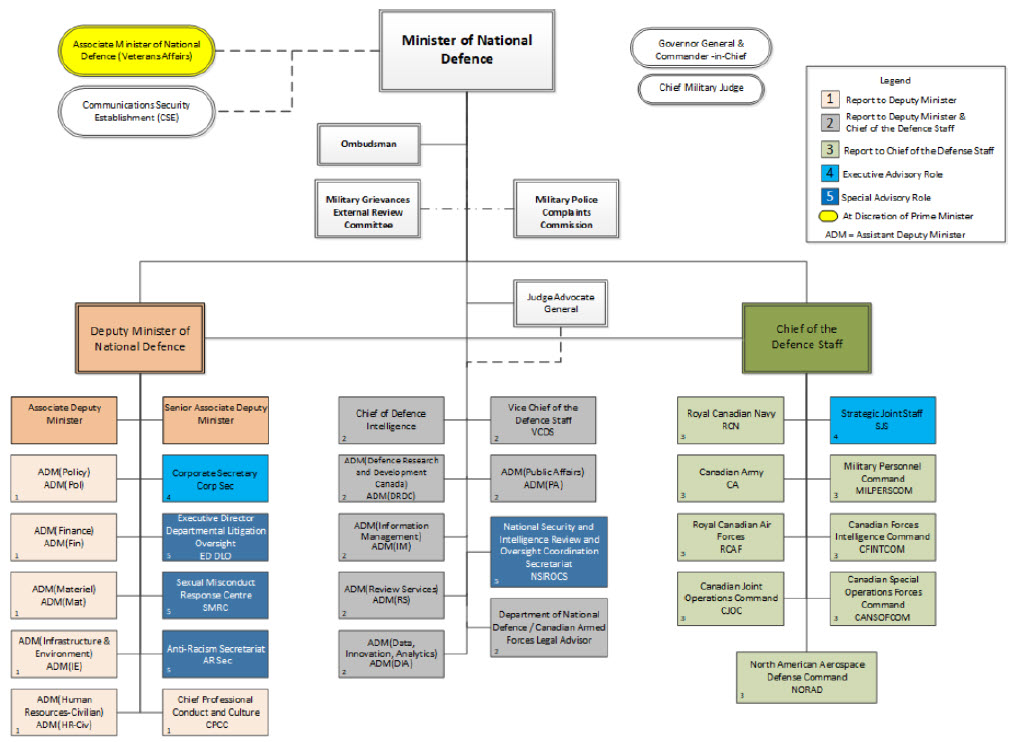
2.3 The Directorate of Access to Information and Privacy
Delegation of authority
In accordance with section 95(1) of the Access to Information Act, a delegation of authority, signed by the Minister, designates the Deputy Minister, Corporate Secretary, Executive Director of Access to Information and Privacy, Access to Information Chief of Operations, and Access to Information and Privacy (ATIP) Deputy Directors to exercise all powers and functions of the Minister, as the head of institution under the Act. It also designates other specific powers and functions to employees within the Directorate Access to Information and Privacy.
Under the authority of the Corporate Secretary, the ATIP Executive Director administers and coordinates the Access to Information Act and the Privacy Act, and acts as the departmental ATIP Coordinator. In the administration of the Act, the ATIP Directorate seeks advice on legal, public affairs, policy, and operational security matters from other organizations and specialists as required.
A copy of the Access to Information Act and Privacy Act Designation Order is provided at Annex A.
The ATIP Directorate
The ATIP Directorate is responsible for matters regarding access to information and privacy protection within the National Defence portfolio, excepting the following organizations: the Military Police Complaints Commission, the Military Grievances External Review Committee, the Communications Security Establishment, the Office of the National Defence and Canadian Forces Ombudsman, the Office of the Chief Military Judge and the Director of Defence Counsel Services, and the Canadian Forces Morale and Welfare Services.
The Directorate’s ATIP program management workforce is divided functionally into four main areas, and supported by Defence organization liaison officers, as illustrated in the diagram at Figure 2.
Figure 2: National Defence ATIP Operational Workforce
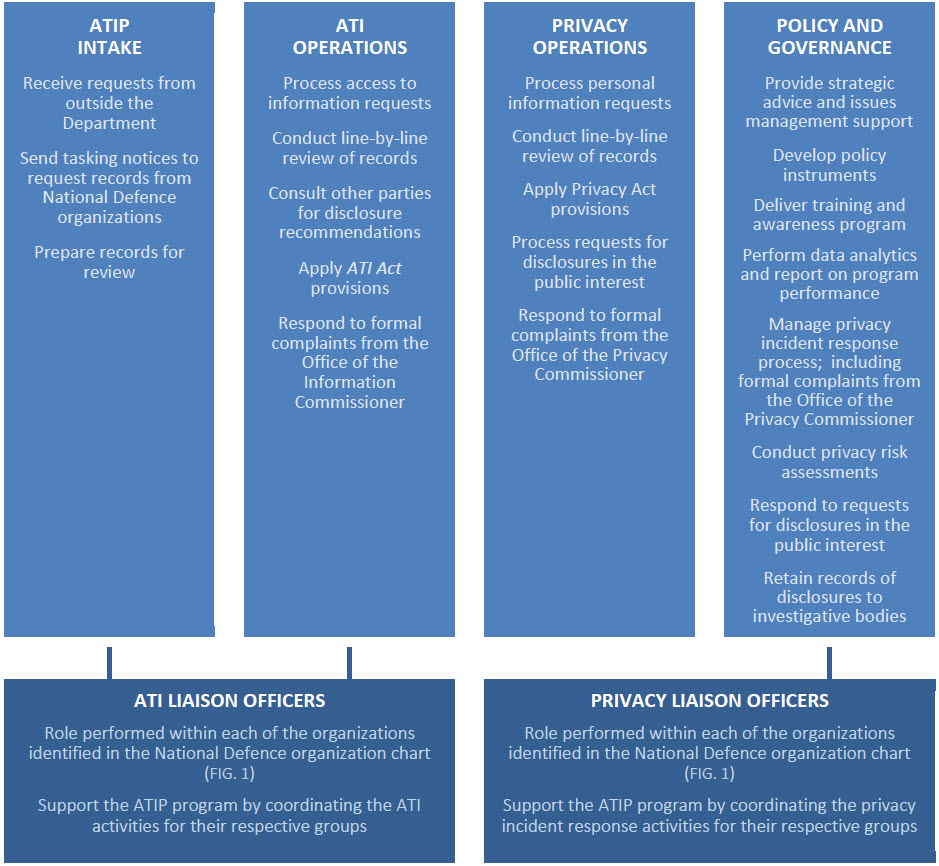
Long description
National Defence ATIP operational workforce
- ATIP Intake receive requests from outside of the Department, send tasking notices to request records from National Defence organizations and prepare records for review.
- ATI Operations process access to information requests, conduct line-by-line review of records, consult other parties for disclosure recommendations and apply Access to Information Act provisions, respond to formal complaints from the Office of the Information Commissioner.
- ATI Liaison Officers is a role performed within each of the organizations identified in the National Defence organization chart. This role supports the ATIP program by coordinating the ATI activities for their respective groups.
- Privacy Operations process personal information requests, conduct line-by-line review of records, apply Privacy Act provisions, process requests for disclosures in the public interest, and respond to formal complaints from the Office of the Privacy Commissioner.
- Policy and Governance provides strategic advice and issues management support, develop policy instruments, deliver training and awareness program, perform data analytics and report on program performance, manage privacy incident response process, conduct privacy risk assessments, respond to requests for disclosures in the public interest and retain records of disclosures to investigative bodies.
- The Privacy Liaison Officers is a role performed within each of the organizations identified in the National Defence organization chart. This role supports the ATIP program by coordinating the privacy incident response activities for their respective groups.
The ATIP Directorate is managed by an Executive Director and supported by a Chief of Operations that oversees all aspects of ATI operations, including intake; and Deputy Directors overseeing Privacy Operations and the Policy and Governance Team.
The Chief of Operations oversees all activities related to access to information. This ensures consistency in the execution of departmental processes and application of the ATI Act and allows for quality assurance activities, tracking, reporting, and monitoring of trends and rising issues.
The ATIP Directorate is supported by a systems liaison team that maintains the ATIP application system/database and provide technical support to members of the team, and a corporate services team that is responsible for the completion of administrative and management functions of the directorate, including business planning, financial management, human resources, physical security, and information and records management (IM/RM).
In addition to access to information and privacy protection activities, the ATIP Directorate provides a supporting role to the Departmental Litigation Oversight-Litigation Implementation Team. The Directorate performs an ATIP-like review of records in support of class action settlements when required.
3. Highlights of the Statistical report
The statistical report at ANNEX B consists of data submitted by National Defence as part of the Treasury Board Secretariat (TBS) annual collection of ATIP-related statistics. The following sections contain highlights, trends and an analysis of notable statistical data from a departmental perspective.
3.1 Requests received
In FY 2021-22, National Defence received 2,523 new ATI requests, a 24% increase from the previous reporting period. Combined with a carry-over of 1,411 files from FY 2020-21, this represents a total ATI workload of 3,667 requests during this reporting period. The number of request files carried over increased to 1,778 in the current reporting period, from 1,271 requests in FY 2020-21.
Figure 3: ATI request workload (Last five years)
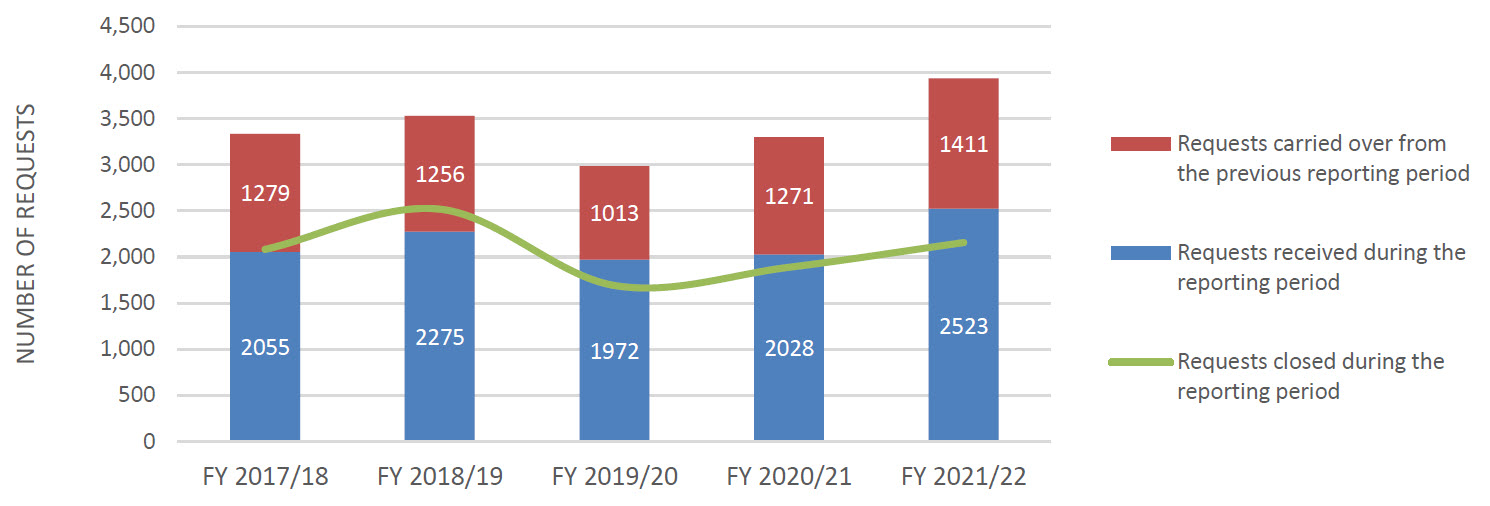
Long description
Access to Information Request workload
- In 2017-2018, 2055 requests were received, 1279 requests were carried over from the previous reporting period. A combined workload of 3334 requests.
- In 2018-2019, 2275 requests were received, 1256 requests were carried over from the previous reporting period. A combined workload of 3531 requests.
- In 2019-2020, 1972 requests were received, 1013 requests were carried over from the previous reporting period. A combined workload of 2985 requests.
- In 2020-2021, 2028 requests were received, 1271 requests were carried over from the previous reporting period. A combined workload of 3299 requests.
- In 2021-2022, 2523 requests were received, 1411 requests were carried over from the previous reporting period. A combined workload of 3934 requests.
Sources of requests
The general public remains the largest source of requests, accounting for over half of all requests received. The remaining sources of requests were more evenly distributed across the remaining categories than noted in previous reporting periods.
Figure 4: Sources of requests received (FY 2021-22)
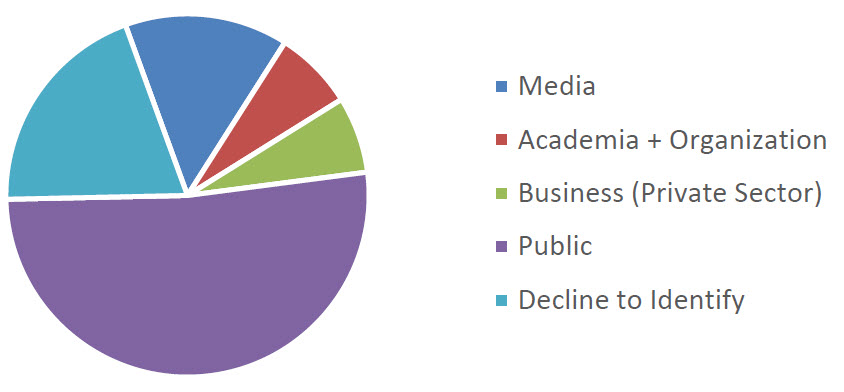
Long description
Sources of Requests Received
- 368 requests were received from Media
- 179 requests were received from Academia and Organizations
- 172 requests were received from Business (Private Sector)
- 1305 requests were received from the Public
- 499 requests were received where the source decline to identify
3.2 Requests completed
A total of 2,156 requests were completed during the reporting period. This is 268 more requests than in FY 2020-21 representing a 19.5% increase over last reporting period, and the third consecutive increase in the number of requests closed. Notably, the total pages processed also increased from 232,550 to 266,367. The five year trend is depicted in Figure 5. This is the fifth consecutive year wherein the pages processed continues to increase.
Two requests were completed during FY 2021-22 in which National Defence neither confirmed nor denied the existence of the records, in accordance with subsection 10(2) of the ATI Act. National Defence only invokes this provision in those limited circumstances where the mere confirmation of a record’s existence (or non-existence) would reveal information that could be protected under the ATIA. Typically, these situations relate to the defence of Canada or the possible disclosure of personal information.
Figure 5: Disposition of Requests Completed and Total Requests Completed (Last Five Years)
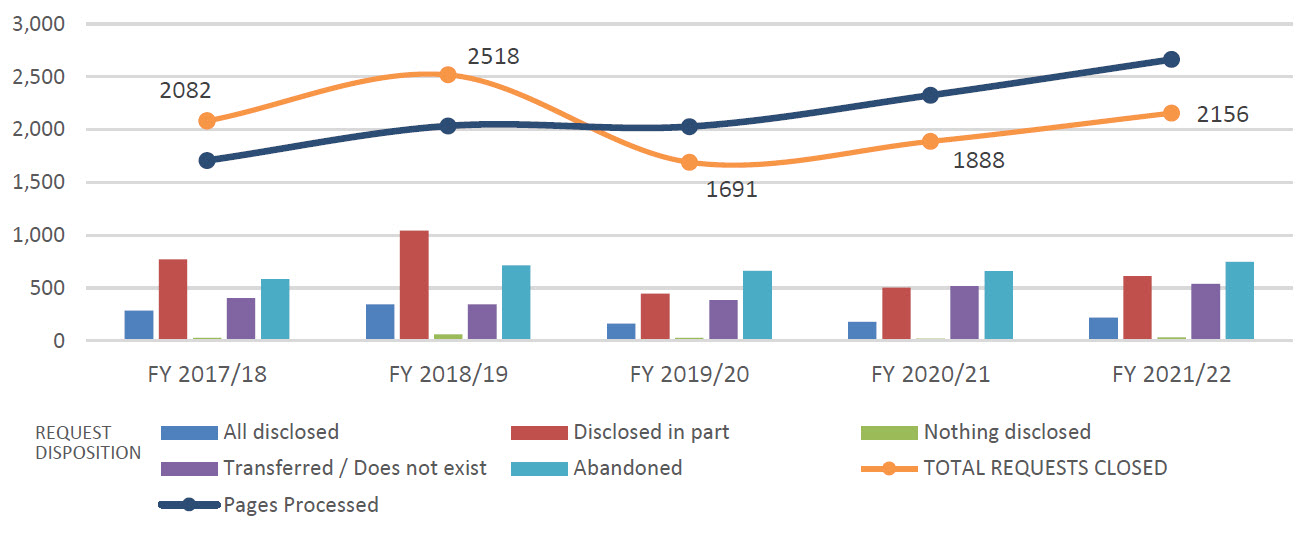
Long description
Disposition of Request Completed and Total Requests Closed
- In 2017-2018, 285 were all disclosed, 773 were disclosed in part, 29 where nothing was disclosed, 405 were transferred or does not exist, and 590 were abandoned. A total of 2082 requests were closed.
- In 2018-2019, 344 were all disclosed, 1047 were disclosed in part, 61 where nothing was disclosed, 349 were transferred or does not exist, and 717 were abandoned. A total of 2518 requests were closed.
- In 2019-2020, 164 were all disclosed, 449 were disclosed in part, 30 where nothing was disclosed, 386 were transferred or does not exist and 662 were abandoned. A total of 1691 requests were closed.
- In 2020-2021, 181 were all disclosed, 504 were disclosed in part, 23 where nothing was disclosed, 519 were transferred or does not exist and 661 were abandoned. A total of 1888 requests were closed.
- In 2021-2022, 220 were all disclosed, 613 were disclosed in part, 32 where nothing was disclosed, 540 were transferred or does not exist and 749 were abandoned. A total of 2156 requests were closed.
A number of requests (678) were abandoned within the first 15 days primarily as a result of the TBS ATIP Online Request initiative where a large number of requests for personal information were submitted under the ATI Act. These files were initially opened as ATI requests but were determined to be more appropriately administered under the Privacy Act.
Disposition: Percentage of requests all disclosed vs. disclosed in part
During the reporting period, National Defence responded to a total of 2,156 requests. A total of 10.2% of requests were “all disclosed” and 28.4% were “disclosed in part.” The remaining requests were completed as all exempted, all excluded, no records exist, request transferred, request abandoned, or neither confirmed nor deny.
Figure 6: All Disclosed Vs. Disclosed in Part (Fiscal Year 2021-22)
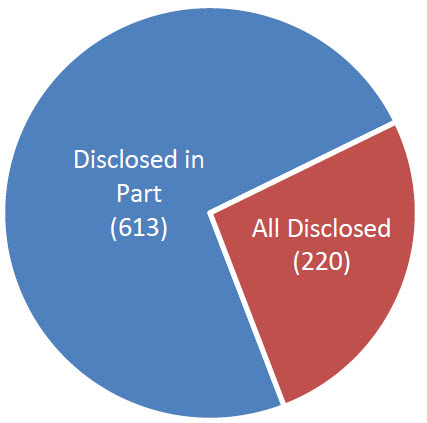
Long description
Requests All Disclosed and Disclosed in Part
- 220 All disclosed
- 613 Disclosed in part
Pages reviewed
The total volume of pages reviewed has continued to increase with 266,367 pages processed during the reporting period; this represents a 14.5% increase in pages processed as compared to FY 2020-21.
As represented in Figure 7, the number of pages reviewed represents the total processed pages for completed requests this FY. This number does not include the number of pages processed for requests that were not completed this FY and carried over into the next reporting period.
Figure 7: Number of Pages Reviewed for Requests Completed Where Records Existed (Last Three Years)

Long description
Number of Pages Reviewed for Requests Closed, where Records Existed
- In 2019-2020, 202 834 pages reviewed for 1305 requests closed
- In 2020-2021, 232 550 pages reviewed for 1369 requests closed
- In 2021-2022, 266 367 pages reviewed for 1616 requests closed
Exemptions and exclusions
Consistent with previous reporting periods, in FY 2021-22, the majority of exemptions applied by National Defence were under the following four sections of the ATI Act:
- Subsection 19(1), which protects personal information of individuals, was applied in 397 requests;
- Subsection 15(1), which protects limited and specific information concerning international affairs and defence, was applied in 367 requests;
- Subsection 21(1), which protects limited and specific information concerning advice and recommendations, was applied in 338 requests; and
- Subsection 20(1), which protects proprietary third-party information, was applied in 215 requests.
Extensions
The ATI Act provides for extending the statutory time limits to respond to a request beyond 30 days if:
- It involves a large number of records or requires a search through a large number of records, and meeting the original time limit would unreasonably interfere with the operations of the institution.
- External consultations are necessary and cannot reasonably be completed within the original time limit is provided at Figure 8.
- Notice to a third party is required to advise them their information is the subject of a request.
Figure 8: Reasons for Extension (FY 2021-22)
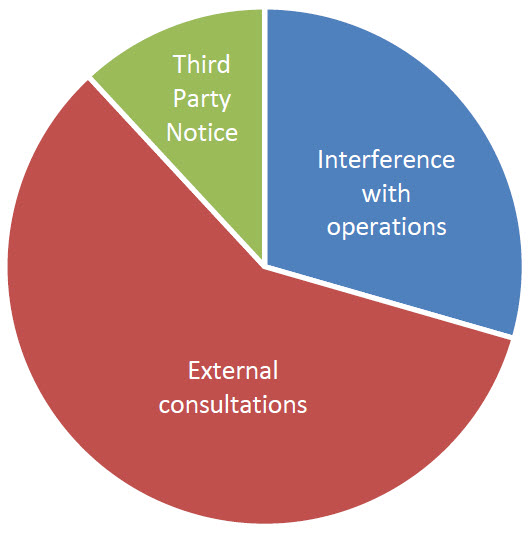
Long description
Reasons for Extension
- 207 extensions were taken for external consultations
- 104 extensions were taken for interference with operations
- 42 extensions were taken for third-party notice
In FY 2021-22, 58.6% of all extensions taken for closed requests were required to conduct consultations with other bodies such as federal government institutions, provincial or municipal governments, or international organizations or governments. The majority of these extensions (76.8%) were for 60 days or less.
The number of extensions taken should not be interpreted as the number of files for which extensions are claimed. A single file could, and quite often does, qualify for multiple extensions. For example, a file could be extended because it has a large volume of records, and also be extended because consultations (one or multiple) are required. This appears in the statistical report as multiple extensions but only for a single file.
Completion time
National Defence noted an 8.4% increase in files closed within 30 days over the last reporting period; 59% of files were closed within 30 days compared to 50.6% closed within 30 days during the previous reporting period. A breakdown of completion time is provided in Figure 9.
Figure 9: Request Completion Time (Last Five Years)
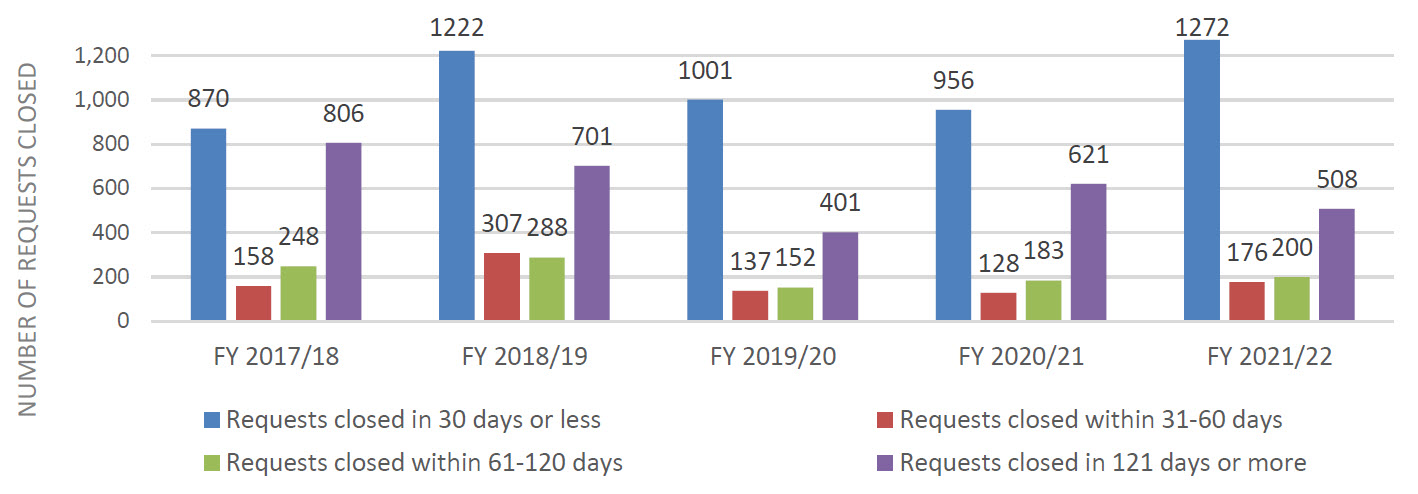
Long description
Request Completion Time
- In 2017-2018, 870 requests were closed in 30 days or less, 158 requests were closed between 31-60 days, 247 requests were closed between 61-120 days and, 806 requests were closed in 121 days or more
- In 2018-2019, 1222 requests were closed in 30 days or less, 306 requests were closed between 31-60 days, 288 requests were closed between 61-120 days and, 702 requests were closed in 121 days or more
- In 2019-2020, 1001 requests were closed in 30 days or less, 137 requests were closed between 31-60 days, 152 requests were closed between 61-120 days and 401 requests were closed in 121 days or more
- In 2020-2021, 956 requests were closed in 30 days or less, 128 requests were closed between 31-60 days, 183 requests were closed between 61-120 days and 621 requests were closed in 121 days or more
- In 2021-2022, 1272 requests were closed in 30 days or less, 176 requests were closed between 31-60 days, 200 requests were closed between 61-120 days and, 508 requests were closed in 121 days or more
Number of Active Requests – Outstanding from Previous Reporting Periods
At the end of the FY 21-22 reporting period, National Defence had 1,778 active requests. A breakdown of outstanding requests by the reporting period in which the request was received, and whether the request is still within the legislated timelines (including extensions) is provided below in Figure 10.
Figure 10: Number of Active requests (as of March 31, 2022)

Long description
Number of Active Requests – Outstanding from Previous Reporting Periods
- Of the requests received in 2021-22 (and active on March 31, 2022), 224 were within legislated timelines; 608 were beyond legislated timelines
- Of the requests received in 2020-21 (and active on March 31, 2022), 4 were within legislated timelines; 411 were beyond legislated timelines
- Of the requests received in 2019-20 (and active on March 31, 2022), 1 was within legislated timelines; 281 were beyond legislated timelines
- Of the requests received in 2018-19 or earlier (and active on March 31, 2022), 3 were within legislated timelines; 246 were beyond legislated timelines
Number of Active Complaints - Outstanding from Previous Reporting Periods
At the end of the reporting period, National Defence had a total 115 active complaints with the Information Commissioner of Canada (OIC). A breakdown of active complaints by reporting period is provided at Figure 11.
Figure 11: Number of active complaints (as of 31 March 2022)
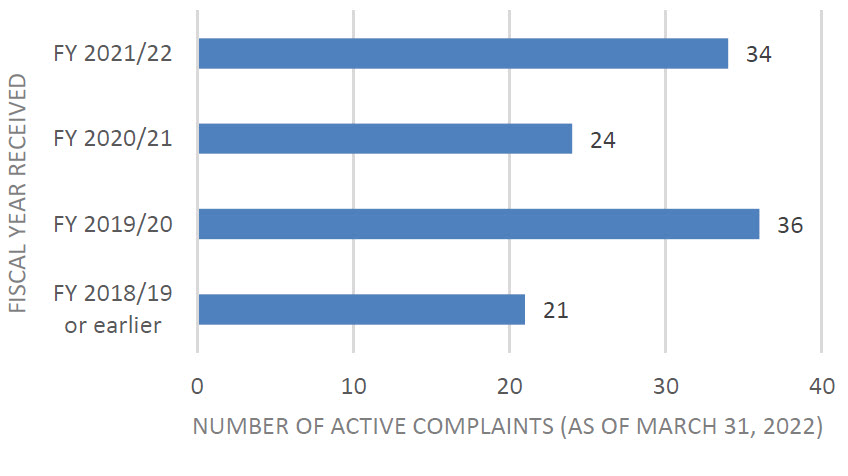
Long description
Number of Active Complaints – Outstanding from Previous Reporting Periods
- Of the complaints active on March 31, 2022:
- 34 complaints were received in 2021-22
- 24 complaints were received in 2020-21
- 36 complaints were received in 2019-20
- 21 complaints received in 2018-19 or earlier
On-time compliance
On-time compliance increased in FY 2021-22; National Defence responded to 67.3% of requests within legislated timelines which represents a 14.3% increase over the last reporting period where 53% of requests were closed within legislated timelines.
The most common reason for deemed refusal was “Interference with Operations/Workload”, which was cited for 59% of requests closed late during the reporting period. As defined by TBS, this reason relates to requests where there is “interwoven information and review is required to determine exemptions, there were a large number of requests to be processed at the time, the request consisted of a high volume of records, there were difficulties in obtaining relevant information, or there were other ATIP-related tasks”. Figure 12 displays the reasons contributing to late file closures in FY 2021-22.
Figure 12: Reasons for Deemed Refusal (FY 2021-22)
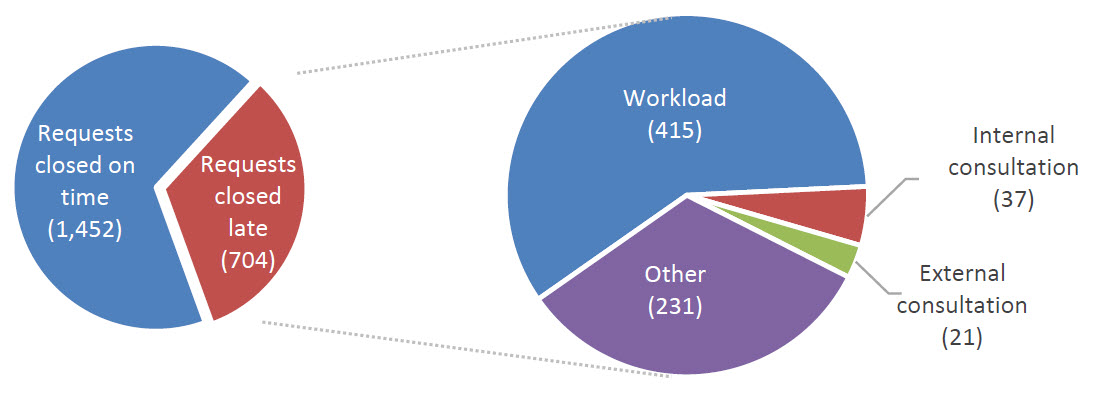
Long description
Reasons for Deemed Refusal
- 1452 requests were closed on time while 704 requests were closed late
- 415 requests closed late is due to workload
- 37 requests closed late is due to internal consultations
- 21 requests closed late is due to external consultation
- 231 requests closed late is due to other factors
Overall, National Defence performance increased during this reporting period. There are number of factors beyond the control of the ATIP office that continue to impact performance and deemed refusal rates; including but not limited to:
- Increased media attention and public interest relating to Departmental priorities such as Sexual Misconduct and class action lawsuits affect OPI ability to retrieve records. Timely review by the ATIP office is further impacted by the complexities inherent is this sensitive and complex information.
- ATIP staffing challenges continue due to a competitive job market. Staff turnover at all levels reduces operational efficiency while new employees onboard and learn. Hiring and training new employees creates additional workload for ATIP management and support services. Efforts continue to recruit and retain talented individuals to staff vacant positions.
3.3 Consultations received and completed
During the reporting period, National Defence received a total of 238 requests for consultation – 222 were received from other Government of Canada institutions and 16 from other organizations. The total workload for consultation requests increased by 5% over FY 2020-21 when 170 consultation requests were received.
While the number of new request for consultations received by National Defence increased this FY, the number of consultations the Department carried over from the previous year decreased. National Defence had 186 consultations pending at the end of this reporting period.
Figure 13: ATI Consultation Workload (Last Five Years)
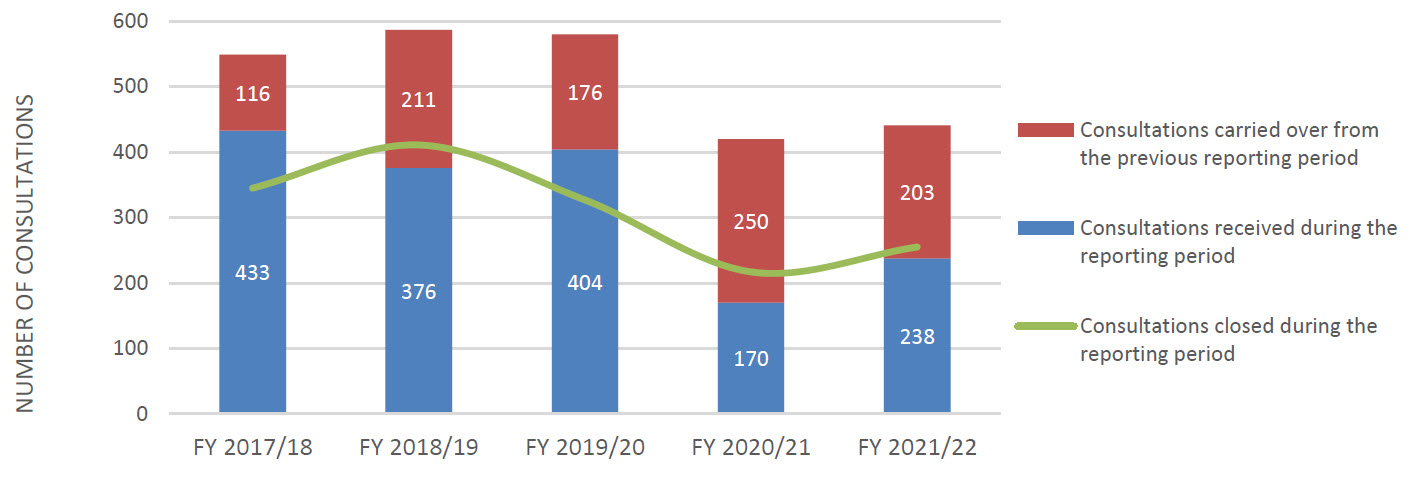
Long description
Access to Information Consultation Workload
- In 2017-2018, 433 consultations were received during the reporting period, 116 were carried over, for a total of 544
- In 2018-2019, 376 consultations were received during the reporting period, 211 were carried over, for a total of 587
- In 2019-2020, 404 consultations were received during the reporting period, 176 were carried over, for a total of 580
- In 2020-2021, 170 consultations were received during the reporting period, 250 were carried over, for a total of 420
- In 2021-2022, 238 consultations were received during the reporting period, 203 were carried over, for a total of 441
3.4 Informal Requests
To support increased transparency and the principles of Open Government, National Defence encourages informal access to records wherever possible. As a result of the online posting of summaries of completed ATIA requests, National Defence continues to see an increase of informal requests for previously released information. In FY 2021-22, National Defence responded to 654 informal requests and 499 of these were completed in 30 days or less.
Figure 14: Informal Requests (Last Five Years)
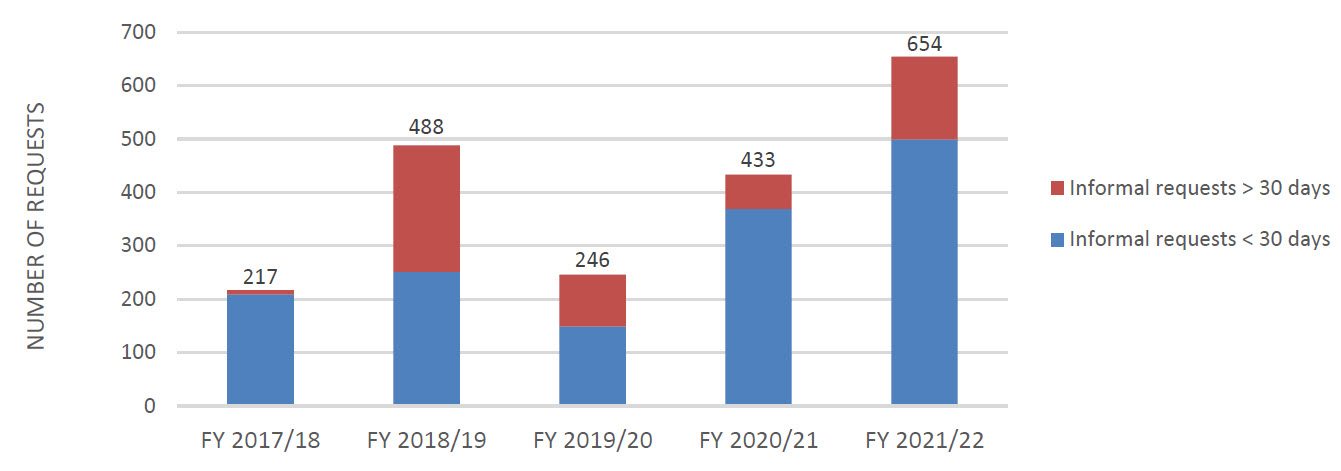
Long Description
Informal Requests
- In 2017-2018, 209 were closed in less than 30 days and 8 in more than 30 days for a total of 217 Informal Requests
- In 2018-2019, 251 were closed in less than 30 days and 237 in more than 30 days for a total of 488 Informal Requests
- In 2019-2020, 149 were closed in less than 30 days and 97 in more than 30 days for a total of 246 Informal Request
- In 2020-2021, 369 were closed in less than 30 days and 64 in more than 30 days for a total of 433 Informal Requests in 2020-2021
- In 2021-22, 499 were closed in less than 30 days and 155 in more than 30 days for a total of 654 Informal Requests
Informal requests reported in this section include:
- Formal requests that were discontinued in favour of providing information informally, in consultation with the requester as part of the Duty to Assist;
- Advising requesters when information is already publicly available online; and
- The re-release of information made available through previously closed formal requests. A listing of ATI requests completed by National Defence is available on the Open Government portal.
4. COVID-19 Impacts to Access to Information operations
As part of the continuing response to the COVID-19 virus, the Department of National Defence evolved from a pandemic state toward an endemic state. The ATIP office remained fully operational during FY 2021-22 reporting period; there were no significant impacts on ATIP performance attributable to COVID-19.
5. Complaints, audits and reviews
5.1 Complaints from the Office of the Information Commissioner
National Defence received a total of 68 complaints from the Office of the Information Commissioner (OIC) in the 2021-22 reporting period; compared to 61 complaints received in the previous reporting period. The number of well-founded complaints remained consistent with 69 well-founded complaints received this reporting period. This represents 3.2% of the total volume of files processed this FY.
Figure 15: OIC findings and nature of well-founded complaints (FY 2021-2022)
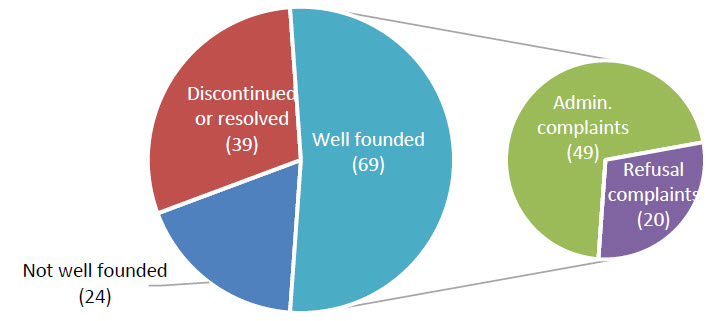
Long description
OIC Findings and Nature of Well-Founded Complaints
- 39 complaints were discontinued, settled, or resolved
- 69 complaints were well founded, 49 of which were administrative in nature (delays and time extensions), and 120 of which were refusal complaints (application of exemptions or possible missing records)
- 24 complaints were not well founded
Statistical reporting requirements for complaints and investigations with the OIC are noted below:
- Section 32: When the OIC gives formal notice of their intention to investigate a complaint regarding the processing of a request under the Act. Defence received 68 such notices during FY 2021-22.
- Section 35: When the OIC requests further representations from institutions pursuant to an ongoing complaint investigation. Defence provided 31 such formal written representations to the OIC during the reporting period.
- Section 37: When the OIC issues a findings report for a well-founded complaint upon conclusion of an investigation. During the reporting period, 69 complaints were found to have merit which is the same as the previous reporting period. The 69 well-founded complaints represent 52.3% of the total findings (132) issued in FY 2021-22.
- Note that these complaints are not necessarily resulting from the 68 complaints received during the current reporting period. Of the 69 well-founded determinations:
- 49 were administrative in nature (about delays and time extensions),
- 20 were refusal complaints (regarding application of exemptions or possible missing records).
- Note that these complaints are not necessarily resulting from the 68 complaints received during the current reporting period. Of the 69 well-founded determinations:
Complaints Team
The ATIP Directorate continued to utilize a dedicated manager to coordinate complaints from the OIC. Dedicated personnel in the ATIP Directorate continued to serve as the primary point of contact for the OIC and assist in complaint-related reporting to both the OIC and ATIP Directorate Management. Regular monthly meetings were undertaken between the OIC and the ATIP Directorate to discuss file progression. These monthly meetings resulted in resolution of complaints and better collaboration with OIC and the ATIP Directorate.
Systemic Investigation
In December 2018, the Information Commissioner (Commissioner) initiated a systemic investigation into the DND/CAF processing of access requests during the period from January 1, 2017 to December 21, 2018.
In July 2020, the Commissioner issued its special report to Parliament (Access at issue: Nine recommendations regarding the processing of access requests at National Defence) which included nine (9) areas of concerns and provided recommendations to address each of the nine areas. The Department agreed with the recommendations and developed a comprehensive Management Action Plan (MAP) to address the findings. In her report, the Commissioner noted the positive collaboration of the Department.
Through addressing and finalizing the MAP recommendations, the Department has collectively improved its ATIP program and is moving forward as an organization that embraces change and continuous improvements to service delivery. Notably, the department has implemented enhanced digital solutions, refreshed policy instruments, renewed the training curriculum and improved process rigour surrounding the tasking and retrieval of information.
The Department continues to show resiliency and dedication to creating a centre of excellence in ATIP and will continue to enhance its ATIP program.
5.2 Court decisions
In FY 2021-22, there were no court proceedings actioned in respect of requests processed by National Defence.
6. Policies and procedures
6.1 Internal procedures
The ATIP Directorate continued to review and update the ATI Procedure Guide to document improvements to ATI request processing and ensure alignment with Treasury Board policies and directives. Changes were made to streamline the record retrieval process in regards to following up on late responses from OPIs, minimizing the amount of email communications and escalating late responses to management. In addition, monthly meetings were held with OPIs who had the highest volume of outstanding files in order to improve communication and to assist them in reducing backlogs.
7. Training and awareness
7.1 ATIP training program
Departmental ATIP training continued to be provided on a virtual platform. Directorate training staff delivered the following training sessions to Defence employees and CAF members with specific emphasis on those staff with ATIP responsibilities:
- Introductory courses (ATIP 101 - General ATIP or Privacy Fundamentals, internal orientation for new staff, Privacy Protection);
- Advanced courses (ATIP 201 - Advanced ATIP or organization-specific content); and,
- ATIP awareness and engagement activities with the various branches and divisions.
7.2 Training and awareness activities
A total of 36 training sessions were delivered to approximately 1,576 which represents a 5% decrease in individuals trained over the previous FY. This training was provided to Defence employees and CAF members on the administration of both the Access to Information Act and Privacy Act, as well as on appropriate management of personal information under the control of the institution. These virtual training sessions included ATIP 101, ATIP 201, and Privacy Protection and targeted training sessions for specific Defence organizations. Most training sessions were delivered by ATIP Directorate staff through video teleconference technologies, and some organizations conducted their own courses and sessions. An example of an organization conducting their own training sessions is the Canadian Forces Health Services group, which covered a variety of Privacy topics.
In FY 2021-2022 the ATIP Directorate implemented a new employee orientation that provides an introduction to ATIP and the roles and responsibilities as an employee of the ATIP Directorate.
In keeping with promoting awareness, ATIP Directorate employees also provided guidance to third parties and requesters on the requirements of the Access to Information Act and the Privacy Act, Treasury Board (TB) policies and directives, and associated institutional procedures as required.
7.3 Tasking Liaison Officer Engagement
The ATIP Directorate conducted a virtual Town Hall in FY 2021-22 with ATIP Directorate staff, OPI, Tasking Liaison Officers and other departmental officials to promote ATIP awareness, and best practices. A guest speaker from the Office of the Information Commissioner discussed the complaint investigation process, and provided insight on the Commissioner’s approval process to decline an access request if, in the opinion of the head of the institution, the request is: vexatious; made in bad faith; or otherwise an abuse of the right to make a request for access to a record.
7.4 Employee well-being
The ATIP Directorate continues to place increased emphasis on directorate staff mental health, awareness and support. In addition to the ongoing ATIP operational training, a session on vicarious trauma training was provided to interested staff which focused on effective and practical strategies for managing indirect trauma exposure and completing the stress cycle in order to improve psychological health and safety.
8. Initiatives and projects
8.1 Backlog Reduction Team
The ATIP Directorate established a dedicated Backlog Reduction Team in October 2019 to address the inventory of late files. This FY an additional position was added to manage large and complex complaint files. This initiative enables other ATI Operations Teams to focus on on-time compliance.
8.2 Technological Improvements
Shift to Paperless processing
A shift towards paperless processing of ATIP requests continued this Fiscal Year. The adoption of electronic processes to reduce paper records such as use of network shared drives to share records electronically between DND/CAF record holders and the ATIP Directorate increased during the COVID Pandemic. The majority of OPIs switched over to electronic processes and are no longer providing paper records to the ATIP Directorate. Electronic signatures on letters to applicants and using Canada Post epost service to share records with applicants versus traditional mail has led to faster access to records for Canadians. This shift to paperless processing enabled the continued processing of ATI requests throughout the various Provincial lock downs.
9. Monitoring compliance
To effectively monitor and report on ATIP performance in National Defence, the ATIP Directorate produces a monthly performance dashboard which tracks OPI record retrieval timeliness, overall ATIP compliance and key metrics such as privacy breach complaints. The ATIP dashboard is tabled monthly at senior level governance committee to ensure visibility on ATIP performance; it is proactively published on the Open Government portal and semi-annually on the DND website. In FY 2021-22, the Departmental ATIP Monthly Performance Dashboard continued to be refined and was transitioned to MS Power BI. The new platform provides better usability and overall visibility to senior leadership on key metrics and overall ATIP performance. The monthly dashboard serves to track ATIP performance across the Department and identify organizations who may require assistance or training, and to identify areas for process improvements. During this reporting period, information relating to the processing of Privacy Informal requests and the identification of errors in titles for briefing notes was added to the monthly dashboard.
The ATIP Directorate routinely responds to ad hoc requests for statistics and performance reports to inform program delivery and identify trends.
10. Access to Information fees and operating costs
10.1 Reporting on ATI fees for the purposes of the Services Fees Act
The Service Fees Act (SFA) requires a responsible authority to report annually to Parliament on the fees collected by the institution. With respect to fees collected under the Access to Information Act, the information below is reported in accordance with the requirements of SFA section 20.
| Enabling authority: | Access to Information Act |
| Fee amount for 2021-22: | $5 application fee is the only fee charged for an ATI request |
| Total revenue: | $11,420.00 |
| Fees waived: | In accordance with the Interim Directive on the Administration of the Access to Information Act, issued on May 5, 2016, and the changes to the Access to Information Act that came into force on June 21, 2019, National Defence waives all fees prescribed by the Act and Regulations, other than the $5 application fee set out in paragraph 7(1)(a) of the Regulations. A total of $1,195 in fees have been waived during this reporting period. |
| Cost of operating the program: | $5,267,284 |
The cost of operations includes salaries, overtime, goods and services, contracts and all other expenses specific to the access to information office. Costs associated with time spent by program areas searching for and reviewing records are not included here.
Annex A: Designation Order
National Defence and the Canadian Armed Forces
Access to Information Act and Privacy Act Designation Order
- Pursuant to section 73 of the Access to Information Act and the Privacy Act, the Minister of National Defence, as the head of a government institution under these Acts, hereby designates the persons holding the following positions, or the persons occupying those positions on an acting basis, to exercise or perform all of the powers, duties and functions of the head of a government institution under these Acts:
- the Deputy Minister;
- the Corporate Secretary;
- the Director Access to Information and Privacy; and
- Deputy Directors Access to Information and Privacy.
- Pursuant to section 73 of the above-mentioned Acts, the Minister also designates the following:
- those persons holding the position of Access Team Leader, or the persons occupying this position on an acting basis, to exercise or perform the powers, duties and functions in respect of:
- The application of the following provisions under the Access to Information Act: section 9; subsection 11(2), 11(3), 11(4), 11(5), 11(6); sections 19, 20, 23 and 24; subsections 27(1) and 27(4); paragraph 28 (1)(b), subsections 28(2) and 28(4); and
- The response to requests made under the Access to Information Act if no records exist.
- those persons holding the position of Privacy Team Leader, or the persons occupying this position on an acting basis, to exercise or perform any of the powers, duties and functions of the head of an institution under the Privacy Act, other than under sub-paragraphs 8(2)(j) and 8(2)(m); and
- those persons holding the position of Privacy Senior Analyst, or the persons occupying this position on an acting basis, to exercise or perform the powers and duties in respect of the application of section 26 of the Privacy Act.
- those persons holding the position of Access Team Leader, or the persons occupying this position on an acting basis, to exercise or perform the powers, duties and functions in respect of:
Original signed by
The Honourable Harjit S. Sajjan, PC, OMM, MSM, CD, MP
Minister of National Defence
Date: 2016-01-12
Annex B: Statistical Report on the Access to Information Act for 2021-2022
Government of Canada
Statistical Report on the Access to Information Act
Name of institution:
National Defence
Reporting period:
2021-04-01 to 2022-03-31
Section 1: Requests Under the Access to Information Act
1.1 Number of requests
| - | Number of Requests | |
|---|---|---|
| Received during reporting period | 2523 | |
| Outstanding from previous reporting period | 1411 | |
Outstanding from previous reporting period |
672 | - |
Outstanding from more than one reporting period |
739 | |
| Total | 3934 | |
| Closed during reporting period | 2156 | |
| Carried over to next reporting period | 1778 | |
Carried over within legislated timeline |
232 | - |
Carried over beyond legislated timeline |
1546 | |
1.2 Sources of requests
| Source | Number of Requests |
|---|---|
| Media | 368 |
| Academia | 105 |
| Business (private sector) | 172 |
| Organization | 74 |
| Public | 1305 |
| Decline to identify | 499 |
| Total | 2523 |
1.3 Channels of requests
| Source | Number of Requests |
|---|---|
| Online | 2348 |
| 66 | |
| 109 | |
| In person | 0 |
| Phone | 0 |
| Fax | 0 |
| Total | 2523 |
Section 2: Informal Requests
2.1 Number of informal requests
| - | Number of Requests | |
|---|---|---|
| Received during reporting period | 669 | |
| Outstanding from previous reporting period | 6 | |
Outstanding from previous reporting period |
6 | - |
Outstanding from more than one reporting period |
0 | |
| Total | 675 | |
| Closed during reporting period | 654 | |
| Carried over to next reporting period | 21 | |
2.2 Channels of informal requests
| Source | Number of Requests |
|---|---|
| Online | 0 |
| 669 | |
| 0 | |
| In person | 0 |
| Phone | 0 |
| Fax | 0 |
| Total | 669 |
2.3 Completion time of informal requests
| Completion Time | |||||||
|---|---|---|---|---|---|---|---|
| 1 to 15 days | 16 to 30 days | 31 to 60 days | 61 to 120 days | 121 to 180 days | 181 to 365 days | More than 365 days | Total |
| 261 | 238 | 102 | 52 | 1 | 0 | 0 | 654 |
2.4 Pages released informally
| Less Than 100 Pages Processed | 101-500 Pages Processed | 501-1,000 Pages Processed | 1,001-5,000 Pages Processed | More Than 5,000 Pages Processed | |||||
|---|---|---|---|---|---|---|---|---|---|
| Number of Requests | Pages Disclosed | Number of Requests | Pages Disclosed | Number of Requests | Pages Disclosed | Number of Requests | Pages Disclosed | Number of Requests | Pages Disclosed |
| 0 | 0 | 0 | 0 | 0 | 0 | 0 | 0 | 0 | 0 |
2.5 Pages re-released informally
| Less Than 100 Pages Processed | 101-500 Pages Processed | 501-1,000 Pages Processed | 1,001-5,000 Pages Processed | More Than 5,000 Pages Processed | |||||
|---|---|---|---|---|---|---|---|---|---|
| Number of Requests | Pages Disclosed | Number of Requests | Pages Disclosed | Number of Requests | Pages Disclosed | Number of Requests | Pages Disclosed | Number of Requests | Pages Disclosed |
| 422 | 9223 | 162 | 32329 | 43 | 30559 | 25 | 40011 | 2 | 17135 |
Section 3: Decline to act vexatious, made in bad faith or abuse of right requests
| - | Number of requests |
|---|---|
| Outstanding from previous reporting period | 0 |
| Sent during reporting period | 0 |
| Total | 0 |
| Approved by the Information Commissioner during reporting period | 0 |
| Declined by the Information Commissioner during reporting period | 0 |
| Withdrawn during reporting period | 0 |
| Carried over to next reporting period | 0 |
Section 4: Requests closed during the reporting period
4.1 Disposition and completion time
| Disposition of requests | Completion time | |||||||
|---|---|---|---|---|---|---|---|---|
| 1 to 15 Days |
16 to 30 Days | 31 to 60 Days | 61 to 120 Days | 121 to 180 Days | 181 to 365 Days | More Than 365 Days | Total | |
| All disclosed | 3 | 51 | 44 | 61 | 30 | 16 | 16 | 220 |
| Disclosed in part | 4 | 34 | 77 | 106 | 73 | 101 | 218 | 613 |
| All exempted | 0 | 7 | 4 | 5 | 7 | 2 | 4 | 29 |
| All excluded | 0 | 1 | 0 | 0 | 0 | 2 | 0 | 3 |
| No records exist | 363 | 81 | 37 | 22 | 7 | 5 | 2 | 517 |
| Request transferred | 23 | 0 | 0 | 0 | 0 | 0 | 0 | 23 |
| Request abandoned | 678 | 26 | 13 | 6 | 1 | 6 | 19 | 749 |
| Neither confirmed nor denied | 0 | 1 | 1 | 0 | 0 | 0 | 0 | 2 |
| Decline to act with the approval of the Information Commissioner | 0 | 0 | 0 | 0 | 0 | 0 | 0 | 0 |
| Total | 1071 | 201 | 176 | 200 | 118 | 132 | 258 | 2156 |
4.2 Exemptions
| Section | Number of Requests |
|---|---|
| 13(1)(a) | 73 |
| 13(1)(b) | 21 |
| 13(1)(c) | 2 |
| 13(1)(d) | 0 |
| 13(1)(e) | 1 |
| 14 | 2 |
| 14(a) | 0 |
| 14(b) | 0 |
| 15(1) | 148 |
| 15(1) - I.A.Footnote * | 74 |
| 15(1) - Def.Footnote ** | 143 |
| 15(1) - S.A.Footnote *** | 2 |
| 16(1)(a)(i) | 2 |
| 16(1)(a)(ii) | 3 |
| 16(1)(a)(iii) | 1 |
| 16(1)(b) | 9 |
| 16(1)(c) | 7 |
| 16(1)(d) | 0 |
| 16(2) | 36 |
| 16(2)(a) | 1 |
| 16(2)(b) | 2 |
| 16(2)(c) | 19 |
| 16(3) | 0 |
| 16.1(1)(a) | 0 |
| 16.1(1)(b) | 0 |
| 16.1(1)(c) | 0 |
| 16.1(1)(d) | 0 |
| 16.2(1) | 0 |
| 16.3 | 0 |
| 16.31 | 0 |
| 16.4(1)(a) | 0 |
| 16.4(1)(b) | 0 |
| 16.5 | 2 |
| 16.6 | 0 |
| 17 | 3 |
| 18(a) | 5 |
| 18(b) | 12 |
| 18(c) | 0 |
| 18(d) | 1 |
| 18.1(1)(a) | 0 |
| 18.1(1)(b) | 0 |
| 18.1(1)(c) | 0 |
| 18.1(1)(d) | 0 |
| 19(1) | 397 |
| 20(1)(a) | 9 |
| 20(1)(b) | 107 |
| 20(1)(b.1) | 0 |
| 20(1)(c) | 87 |
| 20(1)(d) | 12 |
| 20.1 | 0 |
| 20.2 | 0 |
| 20.4 | 0 |
| 21(1)(a) | 142 |
| 21(1)(b) | 137 |
| 21(1)(c) | 39 |
| 21(1)(d) | 20 |
| 22 | 14 |
| 22.1(1) | 0 |
| 23 | 100 |
| 23.1 | 0 |
| 24(1) | 37 |
| 26 | 0 |
4.3 Exclusions
| Section | Number of Requests |
|---|---|
| 68(a) | 9 |
| 68(b) | 0 |
| 68(c) | 0 |
| 68.1 | 0 |
| 68.2(a) | 0 |
| 68.2(b) | 0 |
| 69(1) | 11 |
| 69(1)(a) | 8 |
| 69(1)(b) | 0 |
| 69(1)(c) | 0 |
| 69(1)(d) | 3 |
| 69(1)(e) | 7 |
| 69(1)(f) | 0 |
| 69(1)(g) re (a) | 39 |
| 69(1)(g) re (b) | 0 |
| 69(1)(g) re (c) | 29 |
| 69(1)(g) re (d) | 11 |
| 69(1)(g) re (e) | 10 |
| 69(1)(g) re (f) | 0 |
| 69.1(1) | 0 |
4.4 Relevant pages processed and disclosed
| Paper | Electronic | Other | |||
|---|---|---|---|---|---|
| E-Record | Data set | Video | Audio | ||
| 49 | 784 | 2 | 1 | 3 | 0 |
4.5 Complexity
4.5.1 Relevant pages processed and disclosed
| Number of Pages Processed | Number of Pages Disclosed | Number of Requests |
|---|---|---|
| 266367 | 178233 | 1616 |
4.5.2 Relevant pages processed and disclosed by size of requests
| Disposition | Less Than 100 Pages Processed | 101-500 Pages Processed | 501-1,000 Pages Processed | 1,001-5,000 Pages Processed | More Than 5,000 Pages Processed | |||||
|---|---|---|---|---|---|---|---|---|---|---|
| Number of Requests | Pages Disclosed | Number of Requests | Pages Disclosed | Number of Requests | Pages Disclosed | Number of Requests | Pages Disclosed | Number of Requests | Pages Disclosed | |
| All disclosed | 189 | 2727 | 19 | 2702 | 5 | 3213 | 6 | 8024 | 1 | 9389 |
| Disclosed in part | 354 | 8956 | 150 | 37652 | 55 | 39627 | 47 | 96332 | 7 | 46351 |
| All exempted | 22 | 257 | 4 | 880 | 1 | 646 | 2 | 4240 | 0 | 0 |
| All excluded | 3 | 10 | 0 | 0 | 0 | 0 | 0 | 0 | 0 | 0 |
| Request abandoned | 743 | 41 | 3 | 636 | 1 | 515 | 2 | 4169 | 0 | 0 |
| Neither confirmed nor denied | 2 | 0 | 0 | 0 | 0 | 0 | 0 | 0 | 0 | 0 |
| Declined to act with the approval of the Information Commissioner | 0 | 0 | 0 | 0 | 0 | 0 | 0 | 0 | 0 | 0 |
| Total | 1313 | 11991 | 176 | 41870 | 62 | 44001 | 57 | 112765 | 8 | 55740 |
4.5.3 Relevant minutes processed and disclosed for audio formats
| Number of Minutes Processed | Number of Minutes Disclosed | Number of Requests |
|---|---|---|
| 40 | 2 | 3 |
4.5.4 Relevant pages processed and disclosed by size of requests
| Disposition | Less than 60 Minutes processed | 60-120 Minutes processed | More than 120 Minutes processed | |||
|---|---|---|---|---|---|---|
| Number of Requests | Pages Disclosed | Number of Requests | Pages Disclosed | Number of Requests | Pages Disclosed | |
| All disclosed | 1 | 2 | 0 | 0 | 0 | 0 |
| Disclosed in part | 2 | 38 | 0 | 0 | 0 | 0 |
| All exempted | 0 | 0 | 0 | 0 | 0 | 0 |
| All excluded | 0 | 0 | 0 | 0 | 0 | 0 |
| Request abandoned | 0 | 0 | 0 | 0 | 0 | 0 |
| Neither confirmed nor denied | 0 | 0 | 0 | 0 | 0 | 0 |
| Declined to act with the approval of the Information Commissioner | 0 | 0 | 0 | 0 | 0 | 0 |
| Total | 3 | 40 | 0 | 0 | 0 | 0 |
4.5.5 Relevant minutes processed and disclosed for video formats
| Number of Minutes Processed | Number of Minutes Disclosed | Number of Requests |
|---|---|---|
| 62 | 0 | 1 |
4.5.6 Relevant pages processed and disclosed by size of requests
| Disposition | Less than 60 Minutes processed | 60-120 Minutes processed | More than 120 Minutes processed | |||
|---|---|---|---|---|---|---|
| Number of Requests | Pages Disclosed | Number of Requests | Pages Disclosed | Number of Requests | Pages Disclosed | |
| All disclosed | 0 | 0 | 0 | 0 | 0 | 0 |
| Disclosed in part | 0 | 0 | 1 | 62 | 0 | 0 |
| All exempted | 0 | 0 | 0 | 0 | 0 | 0 |
| All excluded | 0 | 0 | 0 | 0 | 0 | 0 |
| Request abandoned | 0 | 0 | 0 | 0 | 0 | 0 |
| Neither confirmed nor denied | 0 | 0 | 0 | 0 | 0 | 0 |
| Declined to act with the approval of the Information Commissioner | 0 | 0 | 0 | 0 | 0 | 0 |
| Total | 0 | 0 | 1 | 62 | 0 | 0 |
4.5.7 Other complexities
| Disposition | Consultation Required | Assessment of Fees | Other | Total |
|---|---|---|---|---|
| All disclosed | 7 | 0 | 0 | 7 |
| Disclosed in part | 116 | 2 | 0 | 118 |
| All exempted | 1 | 0 | 0 | 1 |
| All excluded | 0 | 0 | 0 | 0 |
| Request abandoned | 1 | 0 | 0 | 1 |
| Neither confirmed nor denied | 0 | 0 | 0 | 0 |
| Declined to act with the approval of the Information Commissioner | 0 | 0 | 0 | 0 |
| Total | 125 | 2 | 0 | 127 |
4.6 Closed requests
4.6.1 Number of requests closed within legislated timelines
| - | Requests closed within legislated timelines |
|---|---|
| Number of requests closed within legislated timelines | 1452 |
| Percentage of requests closed within legislated timelines (%) | 67.35 |
4.7 Deemed refusals
4.7.1 Reasons for not meeting legislated timelines
| Number of Requests Closed Past the Legislated Timelines | Principal Reason | |||
|---|---|---|---|---|
| Interference with Operations / Workload | External consultation | Internal Consultation | Other | |
| 704 | 415 | 21 | 37 | 231 |
4.7.2 Requests closed behond legislated timelines (including any extention taken)
| Number of Days Past Legislated Timelines | Number of Requests Past Legislated Timeline Where No Extension Was Taken | Number of Requests Past Legislated Timelines Where an Extension Was Taken | Total |
|---|---|---|---|
| 1 to 15 days | 45 | 16 | 61 |
| 16 to 30 days | 32 | 11 | 43 |
| 31 to 60 days | 60 | 14 | 74 |
| 61 to 120 days | 90 | 26 | 116 |
| 121 to 180 days | 59 | 13 | 72 |
| 181 to 365 days | 88 | 13 | 101 |
| More than 365 days | 169 | 68 | 237 |
| Total | 543 | 161 | 704 |
4.8 Requests for translation
| Translation Requests | Accepted | Refused | Total |
|---|---|---|---|
| English to French | 0 | 0 | 0 |
| French to English | 0 | 0 | 0 |
| Total | 0 | 0 | 0 |
Section 5: Extensions
5.1 Reasons for extensions and disposition of requests
| Disposition of Requests where an extension was taken | 9(1)(a) Interference with operations | 9(1)(b) Consultation | 9(1)(c) Third-party notice | |
|---|---|---|---|---|
| Section 69 | Other | |||
| All disclosed | 14 | 3 | 27 | 8 |
| Disclosed in part | 77 | 7 | 155 | 33 |
| All exempted | 3 | 0 | 5 | 1 |
| All excluded | 0 | 0 | 0 | 0 |
| No records exist | 8 | 3 | 5 | 0 |
| Request abandoned | 2 | 0 | 2 | 0 |
| Decline to act with the approval of the Information Commissioner | 0 | 0 | 0 | 0 |
| Total | 104 | 13 | 194 | 42 |
5.2 Length of extensions
| Length of extensions | 9(1)(a) Interference with operations | 9(1)(b) Consultation | 9(1)(c) Third-party notice | |
|---|---|---|---|---|
| Section 69 | Other | |||
| 30 days or less | 40 | 3 | 92 | 1 |
| 31 to 60 days | 32 | 9 | 55 | 39 |
| 61 to 120 days | 17 | 1 | 36 | 2 |
| 121 to 180 days | 6 | 0 | 8 | 0 |
| 181 to 365 days | 9 | 0 | 3 | 0 |
| 365 days or more | 0 | 0 | 10 | 0 |
| Total | 104 | 13 | 194 | 42 |
Section 6: Fees
| Fee type | Fee collected | Fee waived | Fee Refunded | |||
|---|---|---|---|---|---|---|
| Number of requests | Amount | Number of requests | Amount | Number of requests | Amount | |
| Application | 2284 | $11,420 | 239 | $1,195 | 0 | $0 |
| Other fees | 0 | $0 | 0 | $0 | 0 | $0 |
| Total | 2284 | $11,420 | 239 | $1,195 | 0 | $0 |
Section 7: Consultations Received From Other Institutions and Organizations
7.1 Consultations received from other Government of Canada institutions and other organizations
| Consultations | Other Government of Canada Institutions | Number of Pages to Review | Other Organizations | Number of Pages to Review |
|---|---|---|---|---|
| Received during reporting period | 222 | 20317 | 16 | 535 |
| Outstanding from the previous reporting period | 200 | 113697 | 3 | 2634 |
| Total | 422 | 134014 | 19 | 3169 |
| Closed during the reporting period | 239 | 21069 | 16 | 347 |
| Carried over within negotiated timelines | 39 | 16513 | 1 | 196 |
| Carried over beyond negotiated timelines | 144 | 96432 | 2 | 2626 |
7.2 Recommendations and completion time for consultations received from other Government of Canada institutions
| Recommendations | Number of Days Required to Complete Consultation Requests | |||||||
|---|---|---|---|---|---|---|---|---|
| 1 to 15 Days | 16 to 30 Days | 31 to 60 Days | 61 to 120 Days | 121 to 180 Days | 181 to 365 Days | More Than 365 Days | Total | |
| Disclosed entirely | 30 | 26 | 31 | 29 | 17 | 17 | 4 | 154 |
| Disclosed in part | 3 | 3 | 11 | 10 | 8 | 10 | 26 | 71 |
| Exempted entirely | 0 | 0 | 0 | 0 | 0 | 0 | 1 | 1 |
| Excluded entirely | 0 | 0 | 0 | 1 | 0 | 0 | 0 | 1 |
| Consult other institution | 0 | 0 | 0 | 0 | 0 | 0 | 0 | |
| Other | 3 | 1 | 0 | 1 | 2 | 3 | 2 | 12 |
| Total | 36 | 30 | 42 | 41 | 27 | 30 | 33 | 239 |
7.3 Recommendations and completion time for consultations received from other organizations
| Recommendations | Number of Days Required to Complete Consultation Requests | |||||||
|---|---|---|---|---|---|---|---|---|
| 1 to 15 Days | 16 to 30 Days | 31 to 60 Days | 61 to 120 Days | 121 to 180 Days | 181 to 365 Days | More Than 365 Days | Total | |
| Disclosed entirely | 1 | 5 | 6 | 2 | 0 | 1 | 0 | 15 |
| Disclosed in part | 0 | 0 | 0 | 0 | 0 | 0 | 0 | 0 |
| Exempted entirely | 0 | 0 | 0 | 0 | 0 | 0 | 0 | 0 |
| Excluded entirely | 0 | 0 | 0 | 0 | 0 | 0 | 0 | 0 |
| Consult other institution | 0 | 0 | 0 | 0 | 0 | 0 | 0 | 0 |
| Other | 0 | 1 | 0 | 0 | 0 | 0 | 0 | 1 |
| Total | 1 | 6 | 6 | 2 | 0 | 1 | 0 | 16 |
Section 8: Completion Time of Consultations on Cabinet Confidences
8.1 Requests with Legal Services
| Number of Days | Fewer Than 100 Pages Processed | 101-500 Pages Processed | 501-1000 Pages Processed | 1001-5000 Pages Processed | More Than 5000 Pages Processed | |||||
|---|---|---|---|---|---|---|---|---|---|---|
| Number of Requests | Pages Disclosed | Number of Requests | Pages Disclosed | Number of Requests | Pages Disclosed | Number of Requests | Pages Disclosed | Number of Requests | Pages Disclosed | |
| 1 to 15 | 23 | 261 | 0 | 0 | 1 | 185 | 0 | 0 | 0 | 0 |
| 16 to 30 | 10 | 126 | 5 | 1194 | 1 | 96 | 0 | 0 | 0 | 0 |
| 31 to 60 | 11 | 198 | 1 | 253 | 0 | 0 | 1 | 161 | 0 | 0 |
| 61 to 120 | 6 | 45 | 0 | 0 | 0 | 0 | 0 | 0 | 0 | 0 |
| 121 to 180 | 1 | 69 | 1 | 53 | 0 | 0 | 0 | 0 | 0 | 0 |
| 181 to 365 | 1 | 69 | 0 | 0 | 0 | 0 | 0 | 0 | 0 | 0 |
| More than 365 | 0 | 0 | 1 | 30 | 0 | 0 | 0 | 0 | 0 | 0 |
| Total | 52 | 768 | 8 | 1530 | 2 | 281 | 1 | 161 | 0 | 0 |
8.2 Requests with Privy Council Office
| Number of Days | Fewer Than 100 Pages Processed | 101-500 Pages Processed | 501-1000 Pages Processed | 1001-5,000 Pages Processed | More Than 5000 Pages Processed | |||||
|---|---|---|---|---|---|---|---|---|---|---|
| Number of Requests | Pages Disclosed | Number of Requests | Pages Disclosed | Number of Requests | Pages Disclosed | Number of Requests | Pages Disclosed | Number of Requests | Pages Disclosed | |
| 1 to 15 | 0 | 0 | 0 | 0 | 0 | 0 | 0 | 0 | 0 | 0 |
| 16 to 30 | 0 | 0 | 0 | 0 | 0 | 0 | 0 | 0 | 0 | 0 |
| 31 to 60 | 0 | 0 | 0 | 0 | 0 | 0 | 0 | 0 | 0 | 0 |
| 61 to 120 | 0 | 0 | 0 | 0 | 0 | 0 | 0 | 0 | 0 | 0 |
| 121 to 180 | 1 | 0 | 0 | 0 | 0 | 0 | 0 | 0 | 0 | 0 |
| 181 to 365 | 0 | 0 | 0 | 0 | 0 | 0 | 0 | 0 | 0 | 0 |
| More than 365 | 0 | 0 | 0 | 0 | 0 | 0 | 0 | 0 | 0 | 0 |
| Total | 1 | 0 | 0 | 0 | 0 | 0 | 0 | 0 | 0 | 0 |
Section 9: Complaints and investigations
9.1 Investigations
| Section 32 Notice of intention to investigate | Subsection 30(5) Ceased to investigate | Section 35 Formal Representations |
|---|---|---|
| 68 | 0 | 31 |
9.1 Investigations
| Section 37(1) Initial Reports | Section 37(2) Final Reports | ||||
|---|---|---|---|---|---|
| Received | Containing recommendations issued by the Information Commissioner | Containing orders issued by the Information Commissioner | Received | Containing recommendations issued by the Information Commissioner | Containing orders issued by the Information Commissioner |
| 2 | 0 | 0 | 69 | 0 | 2 |
Section 10: Court action
10.1 Court actions on third party notifications under paragraph 28(1)(b)
| Section 41 | ||||
|---|---|---|---|---|
| Complainant (1) | Institution (2) | Third Party (3) | Privacy Commissioner (4) | Total |
| 0 | 0 | 0 | 0 | 0 |
10.2 Court actions on third party notifications under paragraph 28(1)(b)
| Section 44 - under paragraph 28(1)(b) |
|---|
| 0 |
Section 11 – Resources related to the Access to Information Act
11.1 Allocated Costs
| Expenditures | Amount |
|---|---|
| Salaries | $3,517,392 |
| Overtime | $33,871 |
| Goods and services | $1,716,021 |
Professional services contracts |
$1,161,828 |
Other |
$554,193 |
| Total | $5,267,284 |
11.2 Human resources
| Resources | Person Years Dedicated to Access to Information Activities |
|---|---|
| Full-time employees | 44.480 |
| Part-time and casual employees | 0.580 |
| Regional staff | 0.000 |
| Consultants and agency personnel | 8.000 |
| Students | 0.580 |
| Total | 53.640 |
Note: Enter values to three decimal places.
Annex C: Supplemental Statistical Report on the Access to Information Act and Privacy Act for 2021-2022
Supplemental Statistical Report on the Access to Information Act and Privacy Act
Name of institution:
National Defence
Reporting period:
2021-04-01 to 2022-03-31
Section 1: Capacity to Receive Requests
Enter the number of weeks your institution was able to receive ATIP requests through the different channels.
| - | Number of Weeks |
|---|---|
| Able to receive requests by mail | 52 |
| Able to receive requests by email | 52 |
| Able to receive requests through the digital request service | 52 |
Section 2: Capacity to Process Records
2.1 Enter the number of weeks your institution was able to process paper records in different classification levels.
| - | No Capacity | Partial Capacity | Full Capacity | Total |
|---|---|---|---|---|
| Unclassified Paper Records | 0 | 0 | 52 | 52 |
| Protected B Paper Records | 0 | 0 | 52 | 52 |
| Secret and Top Secret Paper Records | 0 | 0 | 52 | 52 |
2.2 Enter the number of weeks your institution was able to process electronic records in different classification levels.
| - | No Capacity | Partial Capacity | Full Capacity | Total |
|---|---|---|---|---|
| Unclassified Paper Records | 0 | 0 | 52 | 52 |
| Protected B Paper Records | 0 | 0 | 52 | 52 |
| Secret and Top Secret Paper Records | 0 | 0 | 52 | 52 |
Section 3: Open Requests and Complaints Under the Access to Information Act
3.1 Enter the number of open requests that are outstanding from previous reporting periods.
| Fiscal Year Open Requests Were Received | Open Requests that are Within Legislated Timelines as of March 31, 2022 | Open Requests that are Beyond Legislated Timelines as of March 31, 2022 | Total |
|---|---|---|---|
| Received in 2021-2022 | 224 | 608 | 832 |
| Received in 2020-2021 | 4 | 411 | 415 |
| Received in 2019-2020 | 1 | 281 | 282 |
| Received in 2018-2019 | 2 | 137 | 139 |
| Received in 2017-2018 | 1 | 50 | 51 |
| Received in 2016-2017 | 0 | 44 | 44 |
| Received in 2015-2016 or earlier | 0 | 15 | 15 |
| Total | 232 | 1546 | 1778 |
3.2 Enter the number of open complaints with the Information Commissioner of Canada that are outstanding from previous reporting periods.
| Fiscal Year Open Complaints Were Received by Institution | Number of Open Complaints |
|---|---|
| Received in 2021-2022 | 34 |
| Received in 2020-2021 | 24 |
| Received in 2019-2020 | 36 |
| Received in 2018-2019 | 8 |
| Received in 2017-2018 | 4 |
| Received in 2016-2017 | 1 |
| Received in 2015-2016 or earlier | 8 |
| Total | 115 |
Section 4: Open Requests and Complaints Under the Privacy Act
4.1 Enter the number of open requests that are outstanding from previous reporting periods.
| Fiscal Year Open Requests Were Received | Fiscal Year Open Requests Were Received | Open Requests that are Beyond Legislated Timelines as of March 31, 2022 | Total |
|---|---|---|---|
| Received in 2021-2022 | 578 | 166 | 744 |
| Received in 2020-2021 | 0 | 61 | 61 |
| Received in 2019-2020 | 0 | 9 | 9 |
| Received in 2018-2019 | 0 | 1 | 1 |
| Received in 2017-2018 | 0 | 0 | 0 |
| Received in 2016-2017 | 0 | 0 | 0 |
| Received in 2015-2016 or earlier | 0 | 0 | 0 |
| Total | 578 | 237 | 815 |
4.2 Enter the number of open complaints with the Information Commissioner of Canada that are outstanding from previous reporting periods.
| Fiscal Year Open Complaints Were Received by Institution | Number of Open Complaints |
|---|---|
| Received in 2021-2022 | 25 |
| Received in 2020-2021 | 6 |
| Received in 2019-2020 | 2 |
| Received in 2018-2019 | 1 |
| Received in 2017-2018 | 0 |
| Received in 2016-2017 | 0 |
| Received in 2015-2016 or earlier | 0 |
| Total | 34 |
Section 5: Social Insurance Number (SIN)
| Did your institution receive authority for a new collection or new consistent use of the SIN in 2021-2022? | No |
Page details
- Date modified:

